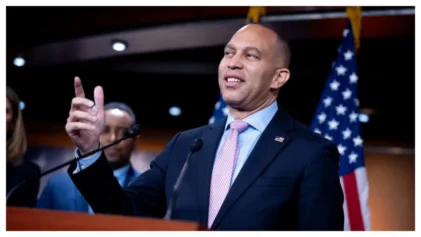At the 2011 White House Correspondents’ Dinner, then-President Obama was facing off with the man that had publicly questioned his American nationality by calling his birth certificate a fraud. That man was Donald Trump.
Obama famously joked at the dinner, “Donald Trump is here tonight! Now, I know that he’s taken some flak lately, but no one is happier, no one is prouder to put this birth certificate matter to rest than the Donald.” The room erupted in laughter as he added, “And that’s because he can finally get back to focusing on the issues that matter, like, did we fake the moon landing? What really happened in Roswell? And where are Biggie and Tupac?”
It was a humbling moment for the real estate mogul-turned-reality TV star who, despite growing up wealthy, had spent most of his life vying for the acceptance of New York’s elite. If Obama touched a nerve that evening, Trump would never admit it, later claiming, “There are many reasons I’m running, but that’s not one of them.” Whether revenge or a bruised ego prompted his political run or not, in the end, Trump would enjoy the final election laugh.
Few are laughing now.
As the White House has shifted from Obama’s famously cool demeanor to the combative governing style Trump frequently displays on Twitter, their differences extend far beyond temperament. Ideologically, the two could not be further apart. Obama, a self-confessed liberal, worked within the system to slowly expand and enforce civil rights. Obama was a meticulous guardian of the American post-World War II governing order and neo-liberal free trade policies. Trump, on the other hand, has spent his time being a right-wing insurgent. His attempts have been to modify the Western international order, pouting about how the United States has been cheated by everyone, except Russia, on international trade policies and military expenditures. While at the same time, Trump has been fighting to slow the tide of white demographic decline with harsh immigration policies.
Since Franklin D. Roosevelt, all modern presidents have been judged by the strides made during their first 100 days in office. For Obama, the first 40 of those days included the passage of a law that expanded the State Children’s Health Insurance Program, another that lifted the Bush-era ban on federal funding for embryonic stem cell research, and an act that promised equal pay for women. Also on his agenda was the stimulus package, narrowly saving the nation from full financial collapse. At the end of his first 100 days, nearly 65 percent of Americans approved of the job Obama was doing.
It was a critical moment in time, described by David Axelrod as, “We knew we were going into one of the worst economic moments since the Great Depression. The financial markets were frozen. The auto industry was about to implode. And that’s just on the domestic side. Those were the knowns.”
For Trump, there has been no honeymoon period. An erratic Trump from his inauguration speech forward has presided over chaos. His controversial immigration orders, Cabinet appointees and media battles have left him with historically low approval ratings. He’s already dropped from 45 percent at his inauguration to 38 percent just four weeks later.
Lacking any substantial ideas or legislation of his own, Trump has dedicated himself to discrediting and dismantling Obama’s legacy. Despite insisting he’s “inherited a mess,” in truth, Trump entered office with a record streak of job growth and a list of Obama-era legislation Republicans were eager to dismantle.
After criticizing Obama’s use of executive orders — 19 of which were signed during his first 100 days in office — Trump pivoted and signed 12 of his own during his first month in office. Using his newfound presidential muscle, he “formally” authorized the “giant border wall” (although no funding has been allocated to it) along the Mexican border and has stricken down federal guidelines that outlined the use of public restrooms for transgender students.
Then, there’s the issue of immigration, a controversy Trump dived blindly into after signing an executive order that banned Iran, Syria, Iraq, Yemen, Somalia, Libya and Sudan nationals. Ill-conceived and poorly executed, with no clear strategy for implementing the order, officials were left scrambling. Meanwhile, those with student visas, valid green cards and even an Iraqi War veteran, found themselves barred from entering the country before a federal judge temporarily halted the decree. It was the type of rookie mistake that, under normal circumstances, would have meant introspection and course correction. But for Trump, it’s been a doubling down on business as usual.
Whereas Obama spent eight years largely downplaying the role that racial bias played during his presidency, Trump has been handsomely rewarded for throwing all political norms out the window, racial niceties included.
The first Black man to lead “the free world” made some eager for what they hoped would be a post-racial America. Obama played down the significance of race in politics and the “pull yourself up by the bootstraps” narrative often uses Obama as an example of what can be achieved in America. But, the message rings hollow. We never entered a post-racial America because it simply doesn’t exist. As the masses chanted “Yes We Can,” others simply fell into the shadows, brought forth again with calls to “Make America Great Again.”
Yes, he “tells it like it is” at the expense of nonwhites, women and everyone else. Though some have willingly accepted his bigotry, others are making their voices heard, as protests continue to rock the country. If the first 30 days are any indicator, the American public will not be stifled.
According to Tim Malloy, assistant director of the Quinnipiac University Poll, “President Donald Trump’s popularity is sinking like a rock. He gets slammed on honesty, empathy, level-headedness and the ability to unite. And two of his strong points, leadership and intelligence, are sinking to new lows. This is a terrible survey one month in.”


